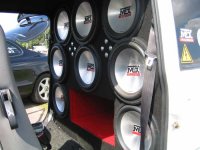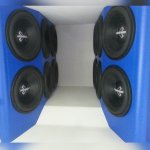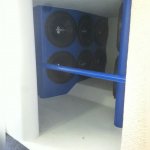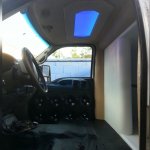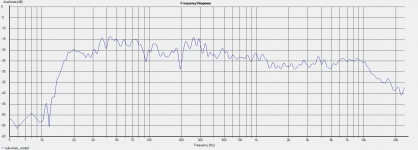About 8 or 9 years ago, if I remember the time correctly, I was using fluid dynamics software to shape enclosures. The idea was to normalize the pressure around the diaphragm's circumference to prevent deformation at low frequencies. Decware also mentioned doing something similar with one of their subwoofers.I've read somewhere that symmetrical port placement is beneficial at high power levels -- supposedly had to do something about equal pressure around the driver...
The port method here is really cool! Two thumbs up.
I have seen advice to keep the port exit at least 1.5 diameters away from box walls and from the cone.I've read somewhere that symmetrical port placement is beneficial at high power levels -- supposedly had to do something about equal pressure around the driver. I don't know how true that is and I'm certainly not going to abuse the driver ..........
I wonder if this could be for similar reasons?
About 8 or 9 years ago, if I remember the time correctly, I was using fluid dynamics software to shape enclosures. The idea was to normalize the pressure around the diaphragm's circumference to prevent deformation at low frequencies. Decware also mentioned doing something similar with one of their subwoofers.
So, how did it work out in the real world? Any real advantages over a conventionally designed box? My guess is, drivers with double spiders, stiff suspension and cones wouldn't benefit as much as more oldschool types with single spider, large Vas and lightweight cones, right?
The port method here is really cool! Two thumbs up.
Thanks!🙂 This simply seemed the most rational and easiest way to arrange and attach the ports. And those large radius 90 degree bends I found at hardware store are godsend😎
I have seen advice to keep the port exit at least 1.5 diameters away from box walls and from the cone.
I wonder if this could be for similar reasons?
Possibly, but it also has to do with retaining the correct tuning -- placing the end near a wall lowers the tuning for the same port length. It's often easier to keep the end away from walls than to try to guess how much shorter the port has to be.
JBL used symmetric 4 vent placement in several of their designs- always made sense to me- one can additionally vary the vent lengths somewhat- helps suppress high-q vent resonances.
Hi AndrewT,I have seen advice to keep the port exit at least 1.5 diameters away from box walls and from the cone. I wonder if this could be for similar reasons?
Perhaps they meant that if the inlet or exit of a port is close to a wall, the tuning will drop, because the wall extends the function of the port.
Some commercial designs have corner ports because it increases the strength and stiffness of the construction.
Cheers,
Djim
1.5 diameters implies the use of a tube port. A tube port end that is more than 1.5 diameters away from the cone has nothing to do with structural integrity.
I've read somewhere that symmetrical port placement is beneficial at high power levels -- supposedly had to do something about equal pressure around the driver. I don't know how true that is and I'm certainly not going to abuse the driver with double the RMS rating amplifier playing low crest factor program hours on end, but I like symmetry, get a bit of OCD with that, even 🙂
Meanwhile, I cobbled together a passive line level crossover and wired my small "lab amp" - a BTL STA540SA ripped out from some cheap PC speakers and fitted with a leftover 18,5 V power supply from my long-dead laptop, yielding around 18 W at 8 ohms - to drive the sub. Sounds good and plenty loud even with that minuscule amp.
That is something car audio guys figured out a long time ago and it is VERY true! Under high power levels, the sub closer to the port in a asymmetrical arrangement will bottom out much faster.
That is something car audio guys figured out a long time ago and it is VERY true! Under high power levels, the sub closer to the port in a asymmetrical arrangement will bottom out much faster.
Can anybody explain the physics or is it just popular myth?
Ben
Can anybody explain the physics or is it just popular myth?
Ben
Def not popular myth lol. I've seen it happen too many times in real world installs. Guys have ripped down walls with hundreds of hours into labor to fix the isue. Guys doing big power installs learned it through trial and error. Tends to be the worst with installs with high port area relative to box size and cone area. Woofers furthest from the port will be fine, whereas the closer ones are audibly under distress. JBL tends to favor symmetrical ports too and they are big on science and experimentation for best real world world results.
As to the why I'm not sure, something with how the port and subwoofers load off each other I'm sure. How you'd model it, if you even can I'm not sure.
Last edited:
Hi AndrewT,1.5 diameters implies the use of a tube port. A tube port end that is more than 1.5 diameters away from the cone has nothing to do with structural integrity.
What I meant is that those corner ports have two walls that extend their function and have their corner ports within 1.5 diameter away from the cone, with no problems...
Cheers,
Djim
Def not popular myth lol. I've seen it happen too many times in real world installs. Guys have ripped down walls with hundreds of hours into labor to fix the isue. Guys doing big power installs learned it through trial and error. Tends to be the worst with installs with high port area relative to box size and cone area. Woofers furthest from the port will be fine, whereas the closer ones are audibly under distress. JBL tends to favor symmetrical ports too and they are big on science and experimentation for best real world world results.
As to the why I'm not sure, something with how the port and subwoofers load off each other I'm sure. How you'd model it, if you even can I'm not sure.
You said "car audio guys" the first time. You were talking about smaller boxes... less than any meaningful fraction of wave-length (20 feet at 50 Hz).
Good other reasons for JBL to favour symmetry for ports.
Myth or can anybody explain the physics?
Ben
Last edited:
You said "car audio guys" the first time. You were talking about smaller boxes... less than any meaningful fraction of wave-length (20 feet at 50 Hz).
Good other reasons for JBL to favour symmetry for ports.
Myth or can anybody explain the physics?
Ben
Define small boxes? I'm talking about guys with 8 15's in a 30+ cubic foot wall with a port big enough to climb into. Can't imagine too many homes with bigger boxes, or more power per sub. The rule of thumb on setups like that is to always use a symmetrical port, or get the subs aligned in such a way that they are equal distance from the port. If not, under high power when playing music, the subs closer to port unload first.
Last edited:
Define small boxes? I'm talking about guys with 8 15's in a 30+ cubic foot wall with a port big enough to climb into.
Attachments
Aah, car audio. A friend of my acquaintance once (rather cynically, he sold and installed car audio) said "another fool paying good money to get his hearing destroyed". I personally don't find 150 dB in a barely 1 cubic meter room that impressive. 120+ dB in open air 20 meters from bass stacks, now that's more like it😀
Here's a total system measurement from listening position. No EQ, 1/12 octave smoothing. PLLXO and aforementioned small amp for the sub.
Here's a total system measurement from listening position. No EQ, 1/12 octave smoothing. PLLXO and aforementioned small amp for the sub.
Attachments
Rare to see a more perfect "house" curve. Even with EQ. At least to my taste.
B.
120 full range destroys hearing pretty fast too. I've been at some loud, very well setup shows and in some very loud cars. They are both fun albeit very different experiences. With today's gear in cars 160 plus is now considered big time numbers for playing music in a car. Pro audio mids an horns, Generally not setup very well though
Pro audio stuff is going lower and lower, I've been at a few shows now that seemed to be pretty damn flat well into the 30hz region. Very impressive considering the venue size and spl achieved. On that note your curve does look very good. Overall looks like something that would sound very flat and still musical.
Last edited:
120 full range destroys hearing pretty fast too.
Of course, probably even faster than 120 dB at 30 Hz. I personally find more than 100 dB at above 1 kHz painful. Ears seem to start to distort, too. That's why I don't enjoy rock concerts without some ear plugs (even simple tissue paper to cut down on high frequencies helps tremendously) anymore - the nonlinearities of my own ears destroy the sound quality🙂
Pro audio stuff is going lower and lower, I've been at a few shows now that seemed to be pretty damn flat well into the 30hz region. Very impressive considering the venue size and spl achieved.
Even a few years ago 50 Hz was considered low enough. These days, 40 Hz is pretty much must-have for everyone. Funny thing though, at these high levels, even if 30 Hz is at -10 dB levels, it still is audible enough to give this big, low bass feeling. I've experienced some really great dub/drum'n'bass etc bass drops on Turbosound TXP-118 active subs -- claimed -3 dB point 45 Hz, starts dropping like stone below 50 Hz judging by the datasheet graph.
Attachments
Of course, probably even faster than 120 dB at 30 Hz. I personally find more than 100 dB at above 1 kHz painful. .
Until recently, it was believed that after the period of "temporary threshold shift" and your hearing returned to baseline, you had no damage.
Turns out, there really is permanent damage to your hearing under those circumstances, according to a recent article I read in Scientific American. Turns out that damage to hearing can be both the familiar frequency response chart as well as to intelligibility of speech separate from FR per se.
Scary, eh?
Ben
Of course, probably even faster than 120 dB at 30 Hz. I personally find more than 100 dB at above 1 kHz painful. Ears seem to start to distort, too. That's why I don't enjoy rock concerts without some ear plugs (even simple tissue paper to cut down on high frequencies helps tremendously) anymore - the nonlinearities of my own ears destroy the sound quality🙂
Even a few years ago 50 Hz was considered low enough. These days, 40 Hz is pretty much must-have for everyone. Funny thing though, at these high levels, even if 30 Hz is at -10 dB levels, it still is audible enough to give this big, low bass feeling. I've experienced some really great dub/drum'n'bass etc bass drops on Turbosound TXP-118 active subs -- claimed -3 dB point 45 Hz, starts dropping like stone below 50 Hz judging by the datasheet graph.
That's the fun part about high effeciency drivers with fairly high f3's. Your 3db down from a really high SPL, meaning on an absolute scale, it's still pretty loud! As I said earlier in this thread, or another Bassnectar has the best bass bar none of ANY concerrt I've ever been at.
Here is what bassnectar uses
PK Sound - Professional Audio Systems & Production
Something like 30+ per side at larger venues like redrocks.
The f3 is listed at 28hz, and that's more or less what my ears told me as well, it seemed to be reaching around 30hz with complete authority. When I saw them in an enclosed venue, I think the f10 became the f3 lol. They werent' even using a big stack of them at that show either, it was like 10-15 per side and you could see the walls moving on low bass notes..
- Status
- Not open for further replies.
- Home
- Loudspeakers
- Subwoofers
- To take a pro 18" down to 20Hz
